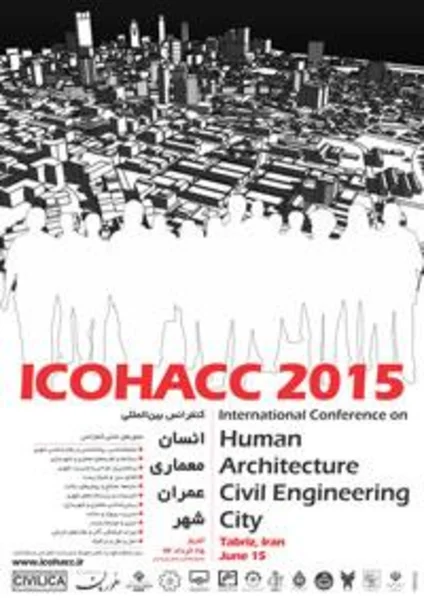-
smart matrials in sustainable architecture and energy efficiancy
جزئیات بیشتر مقاله- تاریخ ارائه: 1394/01/01
- تاریخ انتشار در تی پی بین: 1394/01/01
- تعداد بازدید: 630
- تعداد پرسش و پاسخ ها: 0
- شماره تماس دبیرخانه رویداد: -
investing in refurbishment of existing building stock using energy-saving technologies, such as innovative smart materials, offer an opportunity for housing energy efficiency. building is the sector with the greatest potential for drastically reducing their energy consumption, reaching the zero emission targets, even for producing energy and returning excesses to the common network, but needs to be supported by the right technologies with energy-efficient solutions. new energy efficient technology based on smart materials fast developing and becomes increasingly cost-effective, with much shorter payback periods. however, smart materials are undertaken only on a limited scale, because of lack of knowledge about their changeable properties and dynamism in that they behave in response to energy fields. main characteristics, which make them different from the more commonly used architectural materials, are: immediacy, transience, self- actuation, selectivity and directness. smart materials and systems are divided in two classes, according to their behaviors until energy stimulus from surrounding environment: type 1: materials are those that have capability to change their properties - chemical, mechanical, electrical, magnetic or thermal, including thermochromic, magnetorheological, thermotropic, shape memory alloys. the energy input to a material affects the internal energy of the material by altering the material’s microstructure and the input results in a property change of the material. type 2: materials are those that have capability to transform the energy from one form to another, including photovoltaic, thermoelectric, piezoelectric, photoluminescent and electrostrictive. the energy input to a material changes the energy state of the material composition, but does not alter the material, it stays the same, but the energy undergoes a change. retrofitting homes in this energy-efficient way, in addition to improved indoor climatic conditions, can lead to considerable energy savings together with further enviromental benefits. smart materials, used in the building refurbishment, can produce direct effects on the energy environment (light, heat and acoustic) or indirect effects on building systems (producing energy or mechanical equipment). building components and systems that could be improved by application of smart materials are: facade systems (smart windows) for controlling thermal conduction and sun radiation through building envelope lighting systems (based on optical fiber or light emitting diodes) for optimizing lighting energy systems (photovoltaics, micro and meso energy systems) for energy transmission, controlling of generation of internal heating and for optimizing hvac system technological chain involved in the design, production and implementation of smart materials in refurbishment of existing buildings could allow the energy performance of buildings to influence their value. distributive electricity and heating networks also experience less load intensity due to smart materials, that making better indoor conditions by reducing building’s exposure to the fluctuation of outdoor conditions. in addition to contributing to carbon reduction and energy security, using smart materials in interventions in this sector stimulates innovations and regenerates the built environment.
مقالات جدیدترین رویدادها
-
استفاده از تحلیل اهمیت-عملکرد در ارائه الگوی مدیریت خلاقیت سازمانی و ارائه راهکار جهت بهبود
-
بررسی تاثیر ارزش وجوه نقد مازاد بر ساختار سرمایه شرکت های پذیرفته شده در بورس اوراق بهادار تهران
-
بررسی تأثیر سطح افشای ریسک بر قرارداد بدهی شرکت های پذیرفته شده در بورس اوراق بهادار تهران
-
بررسی تأثیر رتبه بندی اعتباری مبتنی بر مدل امتیاز بازار نوظهور بر نقد شوندگی سهام با تأکید بر خصوصی سازی شرکت ها
-
تأثیر آمیخته بازاریابی پوشاک ایرانی بر تصویر ذهنی مشتری پوشاک ایرانی (هاکوپیان)
-
تاثیر مدارس طبیعت در نهادینگی فرهنگ زیست گرایی جامع بشری
-
مقایسه عوامل مؤثر بر عدم گرایش به نگارش مقالات علمی از دیدگاه اعضای هیأت علمی علوم پایه و بالینی دانشگاه علوم پزشکی همدان
-
بررسی قابلیت لحیم کاری سخت هاردمتال تنگستن کاربید کبالت به فولاد ابزار
-
towards a steady forming condition for radial–axial ring rolling
-
contraction behaviors of dental composite restorations — finite element investigation with dic validation
مقالات جدیدترین ژورنال ها
-
مدیریت و بررسی افسردگی دانش آموزان دختر مقطع متوسطه دوم در دروان کرونا در شهرستان دزفول
-
مدیریت و بررسی خرد سیاسی در اندیشه ی فردوسی در ادب ایران
-
واکاوی و مدیریت توصیفی قلمدان(جاکلیدی)ضریح در موزه آستان قدس رضوی
-
بررسی تاثیر خلاقیت، دانش و انگیزه کارکنان بر پیشنهادات نوآورانه کارکنان ( مورد مطالعه: هتل های 3 و 4 ستاره استان کرمان)
-
بررسی تاثیر کیفیت سیستم های اطلاعاتی بر تصمیم گیری موفق در شرکتهای تولیدی استان اصفهان (مورد مطالعه: مدیران شرکتهای تولیدی استان اصفهان)
-
رابطه اشتیاق شغلی و رشد حرفه ای معلمان بر بالندگی سازمانی در معلمان مقطع اول متوسطه شهرستان خنجین
-
تاثیر تمرکز بازار حسابرسی، تخصص حسابرس در صنعت و تجربه کمیته حسابرسی بر قیمت گذاری حسابرسی
-
مدل سازی خرید مد آنلاین: ارزیابی مبتنی بر خرید حر فه ای مد آنلاین
-
راهکارهایی جهت پرورش ادراک موسیقایی دانش آموزان پایه ابتدایی (مطالعه موردی: بازی و سرگرمی)
-
بررسی نقـش شاخص های بازاریابی در توسعه صنعت گردشگری ورزشی




سوال خود را در مورد این مقاله مطرح نمایید :